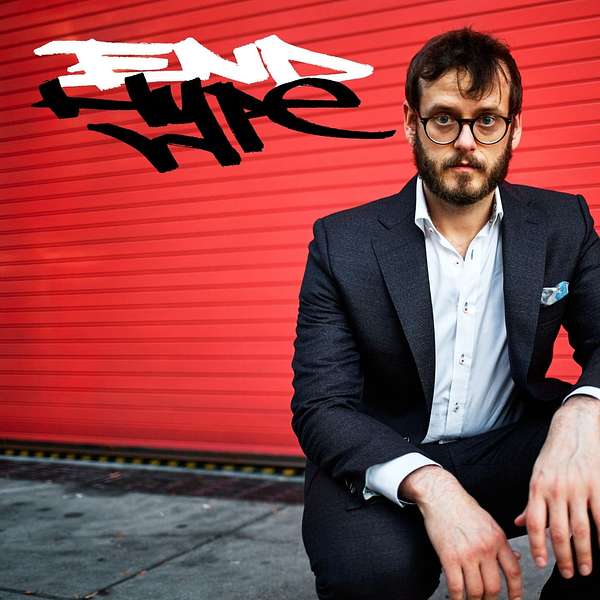
End Hype with Callye Keen
End Hype coaches brilliant misfits, innovators, and outsiders to transform product ideas into business realities from real experience without the fluff. We deliver business knowledge gained from developing and manufacturing 100s of products.
The information comes from hard fought experience working with high-growth startups and major corporations. This show is for entrepreneurs who want better lives, more impact, and greater results. We are for the outsiders who understand action is only path to making the future.
We are sick of ...
- Business books with 200 pages of filler
- Gurus copying and offering useless content
- Venture capitialist bankers offering startup advice
- Fancy talk from fancy people with zero action
Of course not.
We connect with guest experts to accelerate learning to answer new challenges. Our network and community is growing every day. Learn with us and share in the story as we grow.
Entrepreneurs are uniquely capable of improving their lives and their communities. Stop talking about what you could do. Listen in and take action. Innovation changes how we live, work, and interact.
We create new opportunities.
Change your life.
Change the world.
Through collaboratively developing and manufacturing 100s of products, Callye saw a massive range of strategies, tactics, successes, and failures firsthand. He packaged this experience into the Red Blue Collective framework.
Callye has presented at national events, spoken at universities, and ran successful incubator programs. Clients have built 7-8 figure businesses, raised investment, and sold products around the world.
End Hype with Callye Keen
Jamie Grove - From Million Dollar Product Launch to Business
Jamie Grove and Hans Fex launched Mini Museum in 2014 via a Kickstarter campaign that out performed their initial $40,000 ask by more than 25x. Jamie and Hans raised $1.2 million in just 10 days, and that early stage Kickstarter campaign was only the beginning of their insane journey.
Imagine an office that is filled with triceratops horns, samurai swords, pieces of SR71’s, and Steve Jobs turtlenecks. That’s just a sampling of what you would find at the Mini Museum offices.
With a background in development, manufacturing, and fulfillment, Hans and Jamie set out to turn their million dollar product launch into a business. A business founded on interacting with customers, high quality products, and over delivering on customer expectations. A business poised for viral growth.
When Jamie and Hans finished Mini Museum 3, they realized that every time they stepped up to home plate they had to hit a home run. They needed to make enough money to sustain the business for a year or more.
“Manufacturing was our sweet spot. We felt totally comfortable. The question was ‘do we have enough stuff. Do I have enough stuff to make the units we need?’ That was our scary part.”
[05:50 ]Leveraging your expertise
We made calculations based on how much material we had. We didn’t worry about the product development process. At the end of the day that’s what we knew how to do. We knew how to scale up something, manufacturer and ship. A lot of people who get into Kickstarter may have never shipped a single thing in their life.
[07:00] Being transparent with customers to increase brand awareness
That first Mini Museum was really hard because there were just a handful of us. We had a short time window and we almost immediately announced a delay. We were always very open with our backers and worked hard to share information, which made everyone feel connected to our cause.
[10:00] Our products make the world a smaller place
When they get our specimens they ask why they are delivering with such care. And it’s because we care. We are going way above and beyond. We want to deliver something that is super awesome and will last for generations.
[12:25] Leveraging someone else’s traffic to build brand awareness
Part of the reason to use Kickstarter is to get funding but also to get an audience. Kickstarter is expensive money. Nothing beats selling a new product to your existing customers. If you make something that is great, your customers will buy it.
[15:03] The importance of exceptional customer service for longevity
You’ve been around for a considerable amount of time. How do you see the challenge of maintaining that business over time? Customer service. We work really hard to make sure that our customers are taken care of.
[18:50] Reading the market, knowing what customers want, and making it work operationally
Getting more customers on board and sharing more things, you have to get to a lower price point. So we moved to a single specimen model.
[23:40] The importance of keeping your customers engaged
If we were just doing Mini Museums we would only launch one every 18 months, what are we going to do with our customers in between? How many of them will move onto other things and not think about us anymore? Then you’re back into the cycle of acquiring customers.
“There isn’t anybody doing what we do. We welcome competition though, because they are sharing science and history.”
Learn more about Mini Museum
www.minimuseum.com